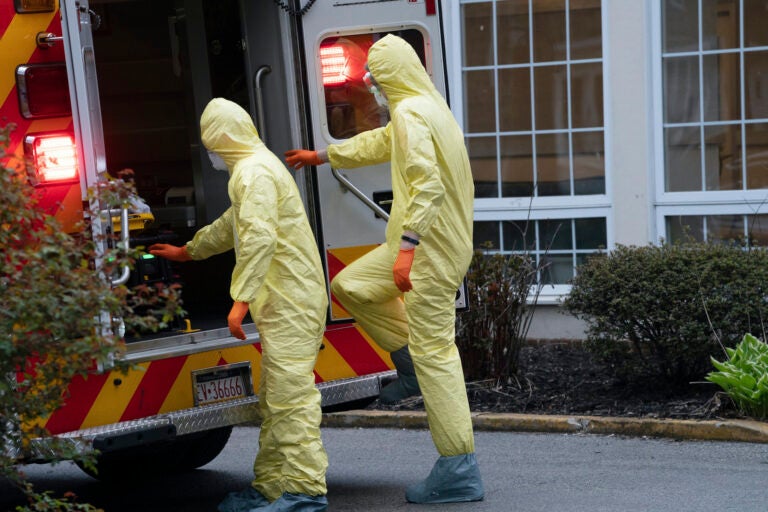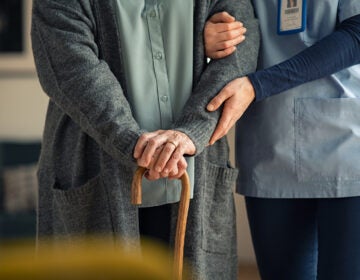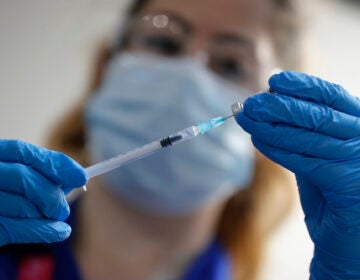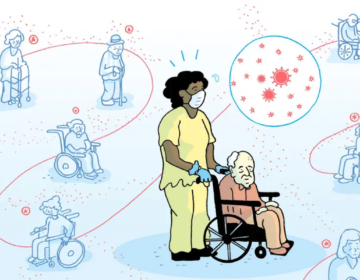Pa. caves to pressure, reveals data showing COVID-19 battered smaller nursing homes
Among facilities in the 5-county region with 5 or more deaths, the average infection rate was 44%; nearly half of residents tested positive, new data show.

Narberth Ambulance Paramedic Andrew Schifferli, left, and EMT Eric McKeever, right, wear full PPE during a call at a nursing home in Wynnewood, PA, on April 17, 2020, in Ardmore, Pa. (Jessica Griffin/Philadelphia Inquirer)
Are you on the front lines of the coronavirus? Help us report on the pandemic.
After weeks of mounting public pressure, the Pennsylvania Department of Health released on Tuesday the number of COVID-19 cases and deaths at each individual nursing home in Pennsylvania.
More than two-thirds of the commonwealth’s 4,624 deaths attributed to COVID-19 have been among residents living in nursing homes and personal care homes, and while the Health Department divided them up by county, it had previously refused to attach case numbers to particular facilities, citing privacy concerns.
Tuesday, that changed.
“Long-term care facility residents are among the most vulnerable Pennsylvanians,” said State Health Secretary Rachel Levine. “We want their families to have the latest information on what is going on in the facilities where their loved ones reside.”
Among facilities in the five-county Philadelphia region with five or more deaths, the average infection rate was 44%, meaning nearly half of all residents tested positive for the virus. On average, facilities across the region lost 12% of their resident populations to COVID-19.
But eight facilities in Delaware, Bucks and Montgomery counties lost more than a quarter of their entire resident population. At the 66-bed Arden Courts of Yardley in Bucks County, 41 people contracted the virus and 23 died –– more than a third of the facility.
At some smaller facilities, like Main Line Health’s Abramson Senior Care, the number of patients who tested positive outnumbered the total number of beds at the facility. Neither a spokesperson for Main Line Health, nor Nate Wardle, spokesman for the Department of Health, was immediately able to explain the discrepancy, but each said they would look into it.
Among the 20 facilities with the highest death rates, only two had capacity to house more than 100 residents, suggesting that the virus may be more lethal or harder to control in smaller facilities.
The raw tallies of COVID-19 cases and deaths were high at some of the region’s largest facilities. The 875-bed Fair Acres in Delaware County saw 155 cases and 29 deaths, for example, but because of that facility’s size the toll amounts to only 3% of all residents dying.
The push for greater transparency began last month, when U.S. Sen. Bob Casey (D-Pa.) demanded that the federal government release a list of facilities with COVID-19 cases. The AARP called on Pennsylvania to do so soon after, and LeadingAge, a trade group representing nonprofit nursing homes, said it was encouraging its members to be transparent with case numbers.
State officials demurred, citing privacy laws and irregular data collection. But after the federal government announced that all long-term care facilities must report case and death counts to the Centers for Disease Control and Prevention, Pennsylvania announced it would release the names of individual facilities.
Some nursing home advocates worry that listing facilities will do little but stigmatize the already under-resourced institutions at a time when they are begging for increased access to testing and personal protective equipment.
“Transparency is only useful if it leads to meaningful intervention,” said Josh Uy, medical director at Renaissance Healthcare and Rehabilitation Center, whose facility was the first in Philadelphia to have a resident test positive. “If it doesn’t lead to help, if it only leads to gawking, then it’s not productive to be transparent at all.”
Uy said that at the height of the chaos, when his facility was doing its best to handle a coronavirus outbreak, the Centers for Medicare and Medicaid Services sent his staff an infection control survey that asked for staffing logs and infection control policy with a one-day turnaround.

Subscribe to PlanPhilly
The pressure was already enormous on his staff, which was busy transferring extremely sick patients to hospice care and hospitals, he said.
“I do think that there’s gonna be a role, once the pandemic settles down, for the regulatory bodies to reset what should have been done and prepare us for the next pandemic,” said Uy. “But right now, what we need to survive is actual support, not just surveys and fines. Naming and shaming is not going to save lives in the middle of a pandemic.”
So far, Pennsylvania quality assurance inspectors have completed 465 infection control inspections, six of which were done in person on site. Another 192 infection control surveys are still in progress.
Wardle said that for facilities with high case counts, a variety of teams have been and will continue to be deployed to offer oversight and assistance ranging from complaint investigation to technical support.
Still, many facilities report a shortage of personal protective equipment and testing kits to appropriately diagnose and treat those with the virus before they develop symptoms and spread it unknowingly.
Earlier this month, Health Secretary Rachel Levine and Govenor Tom Wolf recommended that nursing homes begin testing everyone — staff, residents, those with symptoms, and those without — for the coronavirus. The suggestion marked a change in tune for the administration, whose previous guidance suggested only that patients should be tested when exhibiting symptoms. The new guidance, however, came with no explicit additional resources to facilitate testing.
Yet on Tuesday, Levine said her department was committed to making sure everyone in every facility was tested.
“We’re going to go to those facilities, we’re going to work with them, we’re gonna test every facility,” she said. “It’ll take some time as we have up to 2,000 facilities that we’re talking about, but we’re going to test all those patients and all those residents.”
On Monday, the Department of Health announced that two teams from the Centers for Disease Control and Prevention had been deployed to Pennsylvania. One of them was tasked with helping to develop and implement a testing strategy in nursing homes.
WHYY is your source for fact-based, in-depth journalism and information. As a nonprofit organization, we rely on financial support from readers like you. Please give today.



![CoronavirusPandemic_1024x512[1]](https://whyy.org/wp-content/uploads/2020/03/CoronavirusPandemic_1024x5121-300x150.jpg)




